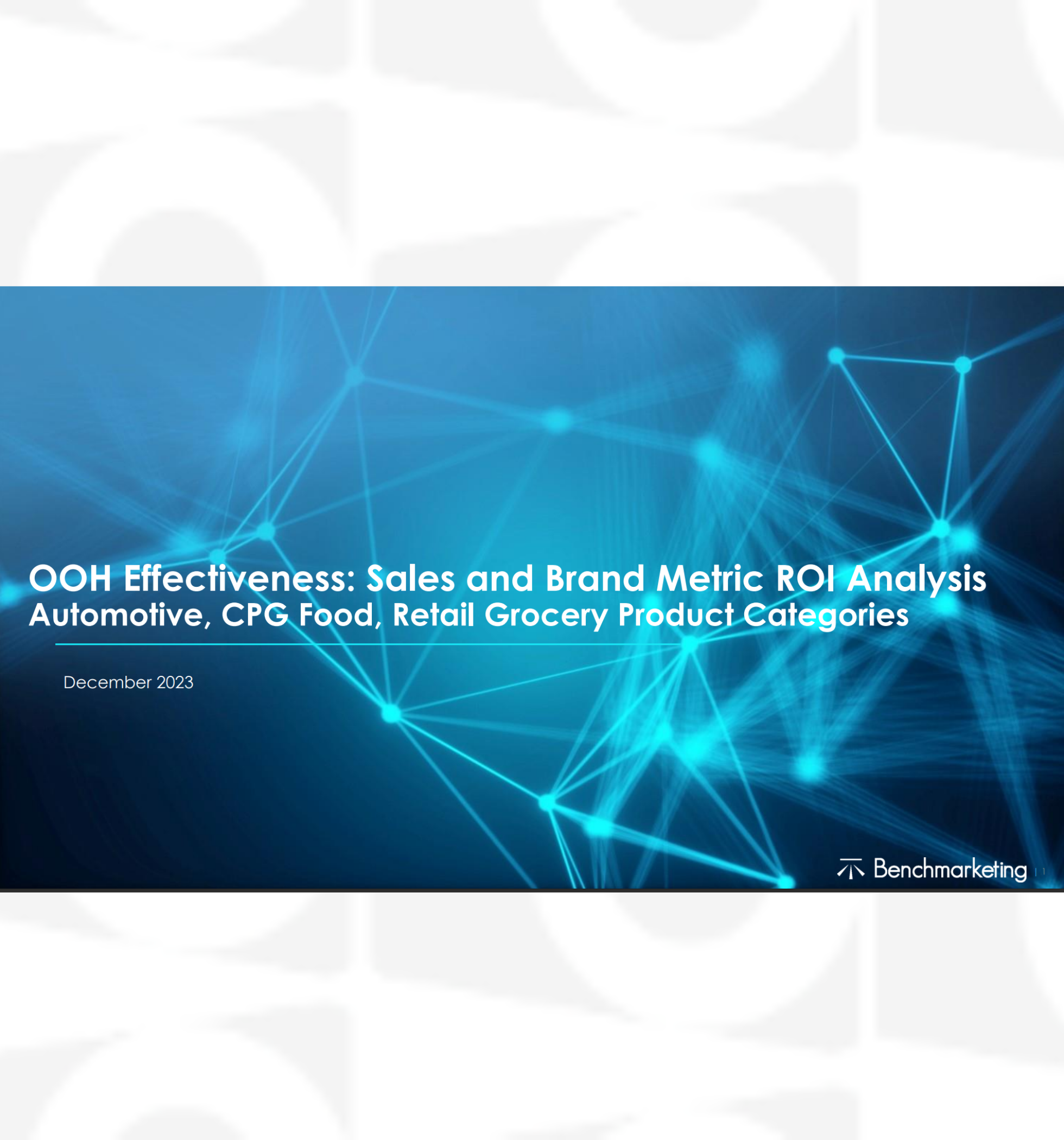
DECEMBER 5, 2023 (WASHINGTON, D.C.) – A new study from Benchmarketing, a division of Omnicom Media Group, found that increasing out of home’s share of media plan allocations leads to increased effectiveness, with measurable impact on sales, brand awareness, consideration, and purchase intent.
The new study commissioned by the Out of Home Advertising Association of America (OAAA) reflects the re-emerging importance of Marketing Mix Modeling (MMM) for brands and advertising agencies to measure and evaluate marketing performance. Due to advancements in machine learning and data analytics, coupled with the ability to factor in variables such as budget spending and economic forces, marketers and advertisers are once again relying on MMM as a tool to measure the impact of a brand’s advertising across various marketing channels.
The new Benchmarketing analysis, which incorporates U.S. brand case studies from the Omnicom network, reaches the same conclusions as previous studies on the value improvement generated by including OOH at significant levels in the media mix.
“Out of home advertising continues to have a significant impact on driving brand perceptions across industries, and as this research suggests outsize returns can be had with just incremental adjustments in spend—especially for automotive, CPG, and grocery retail,” remarked Justin Lewis, Constellation Chair, Co-Founder of Instrument, Stagwell Inc.
The study looked at three product categories: automotive, CPG food, and retail grocery, exploring US ad spend trends across OOH and other media channels, and offering guidelines for allocating media spend levels to optimize improvements in sales and brand metric scores. Key takeaways include:
Automotive
- When looking at brand consideration in the automotive category, the analysis showed the greatest improvement in effectiveness with brand score increases of up to 11% when OOH budget allocation is optimized.
- Automotive has the strongest improvement in driving brand awareness when the mix is optimized and generates brand score increases of up to 19%.
CPG Food
- The CPG food category sees the greatest improvement in brand purchase intent effectiveness when OOH budget allocation is optimized seeing a return on ad spend improvement of up to +24%.
- The CPG food category also sees the highest improvement in increasing consumer brand spend once the media mix is optimized, seeing a return on ad spend improvement of up to +27% to +32%, depending on the size of the brand.
Retail Grocery
- In terms of brand awareness across the retail grocery category, the study’s brand index model showed the greatest improvement in effectiveness when OOH budget allocation is optimized with brand scores increasing up to 9%.
- Large retail grocery brands use OOH at higher levels but should be spending up to twice as much to achieve sales optimization growth of 4%.
Overall, the analysis recommends that marketers and advertisers should start with incremental spending increases in their usage of OOH, rather than making top range optimization changes in existing levels of OOH. To fund the increased OOH spend, the analysis primarily recommends budget shifts away from TV and digital, both of which are over-spent and produce diminishing returns at current levels, as well as print, which often had very small effect in the models.
“This study reaffirms that OOH has higher consumer ad recall than other media and drives more consumer action,” said Anna Bager, President & CEO of OAAA. “The bottom line is there is no other medium that offers effectiveness at a better value. As marketers look to optimize media plans for next year, it’s clear that OOH should receive a higher allocation of the overall budget.”
Key findings from the study will be announced at the Ad Club’s 16th annual Out-of-Home: Now event in New York today. To review all the findings, visit https://oaaa.org/OAAA-Benchmarketing.
Methodology
This study used Vivvix and SMI as key data sources and examined historical ad spend trends from 2017-2002 as part of the analysis. Hundreds of Omnicom U.S. brand MMMs (market mix models of sales vs media activity by channel) were used to produce anonymized and aggregated results. These results were then utilized to generate product category level response curves. For each product category, response curves were created by media channel to determine optimal media mixes.
The Benchmarketing Modeling OOH Media Effectiveness analysis was sponsored by OAAA and The Foundation for Outdoor Advertising Research and Education (FOARE), a 501 (c) (3) not for profit, charitable organization. Benchmarketing is a UK-based strategic marketing effectiveness consultancy and part of the Omnicom Media Group.
About the OAAA The Out of Home Advertising Association of America (OAAA) is the national trade association for the entire out of home (OOH) advertising industry. OAAA represents over 800 members, including leading media companies, advertisers, agencies, ad-tech providers, and suppliers. OOH media includes billboards, street furniture, transit, place-based media, and digital formats (DOOH) across every sector of the channel. OAAA is the unifying voice for the industry, the authoritative thought leader, and the passionate advocate for advancing OOH advertising in the United States. The legislative unit of OAAA advocates for the responsible growth of OOH with federal, state, and local governments. OAAA-member media companies donate over $500 million annually in public service advertising. Founded in 1891, OAAA is headquartered in Washington, DC, with offices in New York City.
# # #
Media Contact
Christine Galetto
DiGennaro Communications
Published: December 5, 2023